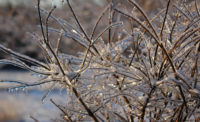Frostbite
Frostbite results from exposure to severe cold. The nose, cheeks, ears, toes, and fingers are the parts most frequently frostbitten.
Symptoms: Frostbite is more likely to occur when a high wind is blowing that takes heat from the body rapidly. Usually frostbite is not associated with pain but rather with a feeling of intense coldness and numbness. The victim may not be aware of frostbite of the cheeks, ears, or nose until someone tells him, or of frostbite of hands or feet until he removes his gloves or shoes. The frostbitten area is dead white.
Treatment:
- Do not rub the frostbitten part.
- Do not expose the part to high temperatures immediately.
- Until the victim can be brought indoors, the frozen part should be covered with woolen cloth or clothing and the victim himself should be made warm with extra clothing or blankets, if possible. As soon as possible, he should be brought into a warm room. He should be given a warm drink.
- The frozen part should be handled with great care in order to avoid injury to it. If it is still cold and numb, it should be re-warmed as rapidly as possible by immersing it momentarily in lukewarm, but not hot, water or by gently wrapping it in warm blankets. Hot-water bottles or heat lamps should not be applied, nor should the frostbitten part be placed near a hot stove. Excessive heat may increase the damage. Once the frostbitten part is re-warmed, the patient should simply be encouraged to exercise injured toes or fingers. Blisters should not be disturbed.
- All frostbites of the second and third degrees should have medical care as promptly as possible.
Freezing
Symptoms: When the entire body reacts to exposure to severe cold the individual becomes numb, exertion is difficult, his eyesight fails, he totters and falls, irresistible drowsiness overtakes him, and he becomes unconscious.
Treatment:
- Procure medical attention as promptly as possible.
- If breathing has stopped, begin artificial respiration. Bring the victim into a warm room as quickly as you can. He should be re-warmed as rapidly as possible, either by placing him in a tub of warm, but not hot, water or by wrapping him in warm blankets. When he reacts, he should be given a hot drink and kept in a warm bed.
- Continue efforts to revive a frozen person for several hours, as persons apparently dead have been restored to life after many hours of treatment.
Source: International Association of Drilling Contractors



